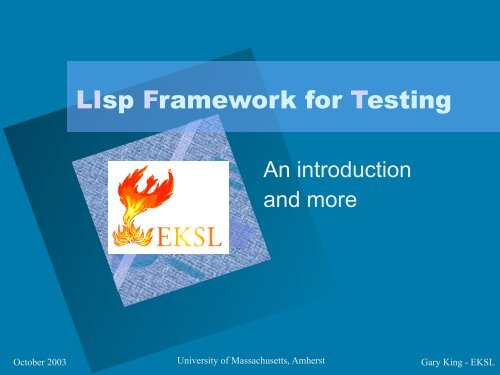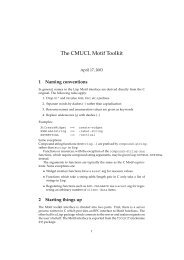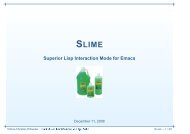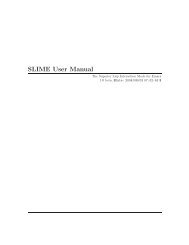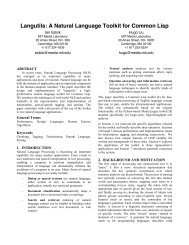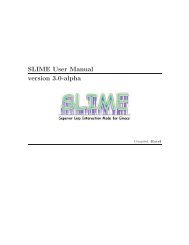LIsp Framework for Testing - Common Lisp.net
LIsp Framework for Testing - Common Lisp.net
LIsp Framework for Testing - Common Lisp.net
- No tags were found...
You also want an ePaper? Increase the reach of your titles
YUMPU automatically turns print PDFs into web optimized ePapers that Google loves.
<strong>LIsp</strong> <strong>Framework</strong> <strong>for</strong> <strong>Testing</strong>AddCorporateLogoHereAn introductionand moreOctober 2003University of Massachusetts, AmherstGary King - EKSL
Outline• <strong>Testing</strong> and LIFT• What’s good about LIFT• Problems with LIFT• What I’d really like to seeOctober 2003University of Massachusetts, AmherstGary King - EKSL
Why Test?• Machines are so fast and storage capacities are so hugethat we face orders of magnitude more room <strong>for</strong>confusion, the propagation and diffusion of which areeasily inadvertently mechanized.-- Edsger W. Dijkstra memo 1243source: http://www.cs.utexas.edu/users/EWD/October 2003University of Massachusetts, AmherstGary King - EKSL
Guidelines <strong>for</strong> Design• Being a better programmer ... is about avoiding thosecomplexities that increase the number of reasoning stepsneeded to keep the design under strict intellectual control.-- Edsger W. Dijkstra memo 1209October 2003University of Massachusetts, AmherstGary King - EKSL
Why Test?• We test to make sure we did what wewanted to do,• We test to make sure we have notundone what we did not want to undo.October 2003University of Massachusetts, AmherstGary King - EKSL
<strong>Testing</strong> in XP• Extreme programming advocates test-a-little /code-a-little programming– In part as a way of growing a design– Enables rapid prototyping and fearless refactoring• A test system provides confidence andincreases the speed of development--changes are less error prone andexperimentation becomes easier.October 2003University of Massachusetts, AmherstGary King - EKSL
<strong>Testing</strong> in <strong>Lisp</strong>…• <strong>Common</strong> <strong>Lisp</strong> has no standard testingtools.• Most testing is done by writing ad hoccode or by using the conditionalevaluation reader macro #+• This style is fine <strong>for</strong> interactivedevelopment but does not supportregression testing or long term stabilityOctober 2003University of Massachusetts, AmherstGary King - EKSL
What is LIFT?• LIFT is a set of macros that make buildingregression tests as easy to build asinteractive ones.• LIFT is a framework that makes it easy tostructure tests into a hierarchy and to giveeach test its own working environment.• LIFT is in the family of Kent Beck inspiredSUnit testing toolsOctober 2003University of Massachusetts, AmherstGary King - EKSL
LIFT has friends(alphabetically)• CLUnit– Adrian• FiveAM– Baringer• SchemeUnit– Welsh et. al.• XPTest– Brozefsky• …• And non SUnit based– Franz Allegro’s– Richard Water’s RT– …October 2003University of Massachusetts, Amherst• Others probablyexist• All are worthy• Combining themwould beworthwhile…Gary King - EKSL
Simple Example(defparameter *filename* "test-file")(defparameter *test-data* '(1 2 3 4));; setup(with-open-file(s *filename* :direction :output)(write *test-data* :stream s))==> (1 2 3 4);; the test(with-open-file (s *filename*)(equal (read s) *test-data*))==> T(deftest test-file-system () ()((filename "test-file")(data (data'(1 '(12 23 34)))4)))(:setup(:setup(with-open-file(with-open-file(s(sfilenamefilename:direction :output):direction :output)(write data :stream s)))(write data :stream s)))(:teardown (delete-file filename)))(:teardown (delete-file filename)))(addtest (test-file-system)read-what-was-written(addtest (test-file-system)(with-open-file (s filename)read-what-was-written(ensure (equal (read s) data))))(with-open-file (s filename)==> (prints) Test passed!(ensure (equal (read s) data))))==> (prints) Test passed!;; cleanup(delete-file *filename*)Success!October 2003University of Massachusetts, AmherstGary King - EKSL
LIFT in a nutshell• deftest– Creates a test class (which will include manytests). The class provides a place <strong>for</strong> commonvariables and <strong>for</strong> test setup and teardown.• addtest– Adds a test case to a test class• run-tests– Runs the test cases in a test class (and itssubclasses)October 2003University of Massachusetts, AmherstGary King - EKSL
Supporting Players• undeftest– Remove a test case from a test class• Ensure, ensure-equal, ensure-warningand ensure-error– Tests an assertion and logs failures anderrors• Plus...– Some variables to control default behaviorOctober 2003University of Massachusetts, AmherstGary King - EKSL
One More Example(deftest test-binary-search-tree ()((b (make-container 'binary-search-tree)))(:setup (empty! b))(:tests((insert-item b 2) ;; test #1(ensure (not (empty-p b))))(ensure (empty-p b)))) ;; test #2(addtest(insert-item b 2)(insert-item b 3)(delete-item b 2)(ensure-equal (size b) 5000)))Whoopts!Test Suite: TEST-BINARY-SEARCH-TREE -- 1 Failure, 0 Errors ***;-----------------------------------Failure: TEST-BINARY-SEARCH-TREE.TEST-4Condition: Ensure-equal: 1 is not EQUAL to 5000 in ((SIZE B) 5000)Code: ((INSERT-ITEM B 2) (INSERT-ITEM B 3) (DELETE-ITEM B 2)(ENSURE-EQUAL (SIZE B) 5000))October 2003University of Massachusetts, AmherstGary King - EKSL
Outline• <strong>Testing</strong> and LIFT• What’s good about LIFT• Problems with LIFT• What I’d really like to seeOctober 2003University of Massachusetts, AmherstGary King - EKSL
The Good• It fits with <strong>Lisp</strong>– Interactive– Clean– Simple• It does what it is supposed to do!October 2003University of Massachusetts, AmherstGary King - EKSL
Outline• <strong>Testing</strong> and LIFT• What’s good about LIFT• Problems with LIFT• What I’d really like to seeOctober 2003University of Massachusetts, AmherstGary King - EKSL
What’s Wrong• <strong>Testing</strong> Macros• Test Organization– Tool integration– GUI, etc.October 2003University of Massachusetts, AmherstGary King - EKSL
Macro Problems• Start with a macro and a test(defmacro my-macro (a b c)`(+ ,a (* ,b ,c)))(deftest test-my-macro () ())(addtest test-1(ensure-equal (my-macro 1 2 3) 7))==> (prints) Test Passed!• Change the macro(defmacro my-macro (a b c)`(list ,a ,b ,c))Uh Oh!(run-test)==> (prints) Test Passed!October 2003University of Massachusetts, AmherstGary King - EKSL
Macro Problems - 2• Work-around: test the expansionOctober 2003(addtest (test-bind)expand-2-in-1(ensure (equal (macroexpand'(bind ((a 1) b)(declare (fixnum a) (dynamic-extent b))))'(let ((a 1))(declare (type fixnum a))(let (b)(declare (dynamic-extent b)))))))– But depends on how the macro works, not onwhat the macro is supposed to do• Can write macros to call functions and thentest these functions• Could use reflection to automatically reevaluatetests with changed macros…University of Massachusetts, AmherstGary King - EKSL
Organization• So many tests, where to put ‘em– Same file? Different files?• So many tests, how to set up ahierarchy• So much old code, how to write tests<strong>for</strong> it all• Need tools to manage it all…– CVS integration, GUI, etc.October 2003University of Massachusetts, AmherstGary King - EKSL
Outline• <strong>Testing</strong> and LIFT• What’s good about LIFT• Problems with LIFT• What I’d really like to seeOctober 2003University of Massachusetts, AmherstGary King - EKSL
Where we are• The code is “ours” (and only ours)• We get feedback from the compiler, fromtools and from execution• Rinse, lather, repeatOctober 2003University of Massachusetts, AmherstGary King - EKSL
What’s missing? Design Checks• Even with organic growth, designsuffers– No way to “codify” the design– Implementation <strong>for</strong>ces compromise• Too much left to the programmer– All that room <strong>for</strong> Dijkstra’s “mechanicallypropagated confusion”October 2003University of Massachusetts, AmherstGary King - EKSL
What we need• Specify code and meta-code– Contracts, constraints, capabilities– Types, yes but also:• This class can never be instantiated directly(generally at run-time),• This class should always precede that class inthe precedence list (generally static)• These classes never get used (runtimein<strong>for</strong>mation)October 2003University of Massachusetts, AmherstGary King - EKSL
And more!• Specification of protocols– Issues in the Design and Specification of ClassLibraries. Kiczales and Lamping, 1992• Examples:– Every method of this GF must call that GF– This method may not be overridden (onlyextended via :after methods)– If this method is overridden, then so must thatmethodOctober 2003University of Massachusetts, AmherstGary King - EKSL
What’s missing: sketching• Human’s are not linear– Many of us like to sketch• But compilers want things in order• <strong>Lisp</strong> does this already– with-compilation-unit• But it could do much moreOctober 2003University of Massachusetts, AmherstGary King - EKSL
What we need• Track problems– Understand whatactions will fix them• cf. Constraintsatisfaction– Interact with person– Facilitate codingas sketchingOctober 2003University of Massachusetts, AmherstGary King - EKSL
YA Programmers Asst.• Let the programming environment share thecode and interact with the programmer– This special variable is declared in “file-1” butused in “file-2” which is loaded be<strong>for</strong>e “file-1”. Doyou want to fix it?– The variable “foo” isn’t used by the function, doyou want to declare it ignorable?• These are mechanical corrections that acomputer can notice and fixOctober 2003University of Massachusetts, AmherstGary King - EKSL
Declarative Compilation• If compiler optimizations are encodeddeclaratively as rules and trans<strong>for</strong>mations• Then the system could infer that knowingmore about types could provide “meaningful”optimizations in speed or time• I.e., the programming environment could say– “It looks as if array is a simple-vector, declaring itso should double the speed of function foo.”October 2003University of Massachusetts, AmherstGary King - EKSL
Related work• Declarative Meta-programming– http://prog.vub.ac.be/research/DMP/– “The aim is to try to capture and <strong>for</strong>mally express the interactionbetween the higher phases of software development (design,analysis, etc...) and the actual implementation level.”• Flavors could capture parts of the design– :required-methods, :required-flavors, etc…• Refactoring code browsers– Eclipse and IntelliJ <strong>for</strong> Java– Refactoring Browser <strong>for</strong> SmallTalk• Programming by trans<strong>for</strong>mation, etc…October 2003University of Massachusetts, AmherstGary King - EKSL
Big Fuzzy Bubble PictureOctober 2003University of Massachusetts, AmherstGary King - EKSL
Caveat• LIFT exists, the rest of this is handwaving.• I’d love to hear comments, critiques andstories of what’s been done and whatcan be done better.• E-mail me at gwking@metabang.comOctober 2003University of Massachusetts, AmherstGary King - EKSL


